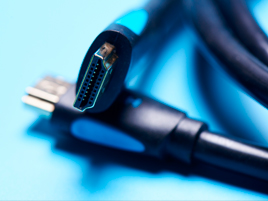Brought to you by Primus - a smart choice for your Internet and Home Phone services.

If you have a TV, gaming system, or computer monitor, you have at least one HDMI cable somewhere in your home. But what exactly are HDMI cables, how do they work, and most importantly, how can you shop for one without wasting a bunch of money? We’re here to help.
What Is an HDMI Cable?
HDMI stands for high-definition multimedia interface. They’re used for transmitting digital video and audio from a source (i.e., a TV box, gaming console, or computer) to a TV, monitor, or projector.
Are There Different HDMI Connection Types?
Yes. There are three different heads you can get for HDMI: standard, mini, and micro. They all work roughly the same and are just used for different devices. On your TV, computer, and gaming console, you’ll see a standard HDMI connector. Mini is more frequently seen in tablets or cameras. Micro connectors are used for phones.
You can also get HDMI connections that are right-angled for space saving, gripping/locking, or panel mounting, if you so need.
Are There Different HDMI Standards?
Yes. The current standard is HDMI 2.1, which has a maximum resolution refresh rate of 8K at 30 Hz, a maximum transmission rate of 48.0 Gb/s, supports HDR (high dynamic range), and uses the audio standard eARC (enhanced audio return channel, the new standard for audio).
This is the important part. Every HDMI cable that is an HDMI 2.1 can do these things. There’s no difference between a $15 cable and a $100 cable in terms of the resolution they will display. Very expensive HDMI cables like to throw around gimmicky terms like oxygen-free copper connectors, silver-plated, gold-plated, zinc connection housing, and more. Without going into the weeds, these marketing terms either advertise stuff that every HDMI cable has or stuff that HDMI cables do not need.
Again: the HDMI 2.1 cable you buy at your local big box store will have the same capabilities as the one your brother-in-law got from a special high-end online retailer and set him back a few hundred bucks. He may swear up and down that his image “looks sharper,” but that’s not true. If you’re watching a 4K stream on a 4K TV, a special cable won’t add any resolution. Also, with digital signals, either they work or they don’t. When they aren’t broadcasting properly, you’ll see artifacting, a line or pixels not lighting up, or just a blank screen. If you really want to see how silly a $1,000 cable is, you can watch this takedown.
But That Means There Are Lesser Standards, Right?
Yes. HDMI 2.0, for example, only does 5K at 30 Hz with a transfer speed of 18.0 Gb/s and has some different audio standards. And the original HDMI 1.0 only did 1080p at 60 Hz with a transfer speed of 4.95 Gb/s.
But here’s the thing: HDMI was the standard back in 2002. Even HDMI 2.0 is from 2013. The current standard, HDMI 2.1, has been the standard since 2017. It isn’t special and isn’t hard to find at all. And honestly, many Canadians don’t even use an 8K TV. If anything, the current standard is overkill—and that’s a good thing.
So How Should I Shop?
The great thing about the HDMI organization is they regulate not just the standards but also the labels. If you’re looking for an HDMI 2.1 cable, this is the logo you need. As long as the cable you’re buying has the label from the HDMI organization, you’re fine.
Should I Ever Pay More for an HDMI Cable?
There are three things that will increase the price of your HDMI cable. The first is length. Obviously a 100-foot cable will cost more than a six-foot one.
The second is braiding. As with any cable, a braided sheath is useful if you plan on taking your cable places and manipulating it a lot. If you’re just plugging it in behind your TV and forgetting about it, don’t worry about braiding.
The third thing you might pay more for is a special connector. As mentioned, they make right-angle connectors or gripping and locking ones. If you need something like that, you might have to spend a few bucks more than standard. But that’s all you should pay more for; there’s no special cable out there that will magically improve your resolution for a few hundred bucks extra.





